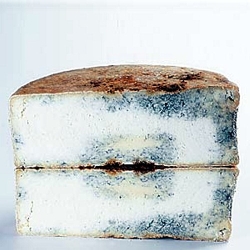Murianengo cheese

Region: Piemonte
Milk: Cow, mixed
Definition: Fresh, marbled, mature cheese.
Raw material: Cow’s milk mixed (not always) with ewes. or goats' milk, starter culture (Penicillium), rennet, salt.
Characteristics: Cylindrical form with regular flat faces, round, with a diameter of 25-35 cm and sides of 12-18 cm in height; weighs 8-12 kg. The natural rind is coarse, yellow-reddish, and can be oiled, in which case it is smooth and a burnished colour.
Production area: Altipiano del Moncenisio, the southern slopes of the Colle del Frejus up to the municipalities of Bardonecchia, Exilles, Novalesa, Clavière etc.
Production technique: Single-curd variety. The evening milk yield is partially skimmed and then mixed with the whole milk from the morning yield. The milk is coagulated at 30 – 35 °C in around 40 minutes. The curds are then broken, first into large lumps and then small pieces of 1 – 3 cm.
They are then left to stand for 10 – 15 minutes after which the curds are extracted from the whey, placed in cloths and left to ferment for about one hour. Immediately after, salt is mixed into the curds (5 kg of salt to 10 quarts of milk). The curds are again wrapped in cloth and placed in moulds. They are left for 24 hours at a temperature of 20-24°C, during which they are turned 2-3 times. The curds are then removed from the moulds, placed on wooden boards, dry-salted and left for 3-4 days. After this, the cheese is stored in maturing rooms. The product is ready to eat after at least 4 months of ageing and not more than 7 months. Perforation is not obligatory as natural cracks in the rind allow air to enter into the cheese. In any case, this would be carried out 20 days after preparation.
Double-curd variety: the curds are mixed with those produced the previous day.
Materials used
- utensils used for making and cutting the curds in the vat: wood or stainless steel;
- containers and moulds: wood, plastic or stainless steel;
- curd draining cloths: natural fabrics;
- aging boards: wood
Reference: Alpinet Gheep
Calories in different varieties and various types of cheeses
The number of calories in various types of cheese is very similar when you compare your cheese to a similar types of cheese.
For example, almost cheeses that are similar to Cheddar cheese have around 400 calories per 100g
If the Murianengo cheese is not listed below, select a similar type of cheese from the list below to get a rough idea for the number of calories in Murianengo cheese.
The calorie lists are sortable by clicking the up and down arrows in the heading columns
| Cheese type | Calories per 100g |
|---|---|
| American cheese | 371 |
| Blue cheese | 353 |
| Camembert cheese | 299 |
| Cheddar cheese | 402 |
| Cottage cheese | 98 |
| Edam cheese | 357 |
| Farmer's cheese | 98 |
| Feta cheese | 264 |
| Fontina cheese | 389 |
| Goat cheese | 364 |
| Gouda cheese | 356 |
| Gruyere cheese | 413 |
| Mozzarella cheese | 280 |
| Parmesan cheese | 431 |
| Pimento cheese | 375 |
| Provolone cheese | 352 |
| Queso blanco cheese | 310 |
| Ricotta cheese | 174 |
| Roquefort cheese | 369 |
| Swiss cheese | 380 |
Discover Cookipedia's Culinary Creations on Pinterest
Explore the vibrant world of Cookipedia through our Pinterest page! We've curated a stunning collection of recipes that highlight the beauty of home-cooked dishes. It's the perfect way to visually navigate our extensive recipe library and get inspired by the flavours we’ve shared over the years. Dive in and discover your next favorite meal—one picture at a time!
Errors and omissions
If you are a cheese producer and your cheese does not appear to be listed on Cookipedia or the information on your cheese is incorrect or out of date, please use the Contact the Editor page to send us a message and we will update the information on your cheese.
#murianengocheese #curds #curd #cow #cheese #starter #italiancheeses #mixedmilkcheeses #ewes #goatsmilk #cheeses